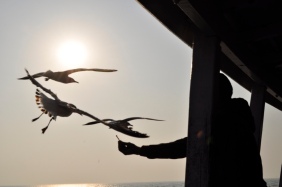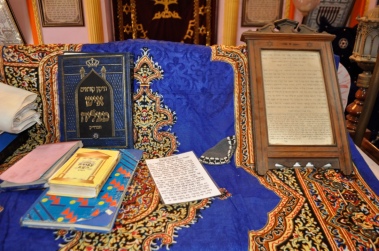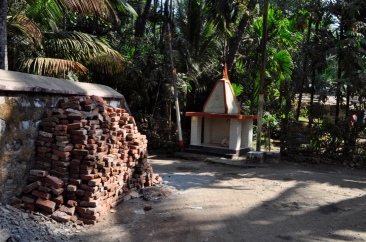As our excursion to India was a genuine, authentic OU “adventure,” it goes without saying that every morsel of food we ate was kosher and that we as a group prayed three times a day. Most of the time, the davening was standard – nothing to write home about. However, the morning minyan the second day was a little out of the ordinary. The plan was for us to board a boat and head down to an island south of Mumbai, where we would get on a bus and drive to a small village to visit a Bene Israel synagogue. Someone had this bright idea: Why don’t we daven shacharit on the boat? Then we can have a pre-packaged breakfast while we’re traveling. We can save time that way. There’s a large box somewhere out there to put all the plans that “seemed like a good idea at the time,” and this doozy certainly would qualify!
On the bus early in the morning, taking ourselves and our provisions to the boat waiting for us at the waterfront not so far away. Off went the boat, and up went the men – onto the upper deck with our “equipment” for our morning prayers. About seventeen men standing on an open deck, each one wrapped in a tallit and tefillin, each one trying to keep his balance as the boat rocked in the water. At one point, a brightly colored fishing boat approached and passed us. “How picturesque,” I thought, although I was obviously not in camera-ready mode. But then I realized that there was an other side to the story. Imagine these fishermen returning home to their wives that evening. “You’ll never guess what we saw today! There were these crazy guys wrapped in sheets, standing together on a boat.”
You know me: not someone to stand on ceremony. Or on top of a boat, either. After a few minutes of trying to keep it all together: my tallit (the one I just had dry-cleaned) from blowing off or the fringes from getting too wet from the water on the deck, my kippah from joining the flotsam and jetsam in the Arabian Sea, all the while clutching my siddur with my third hand, trying to concentrate on my prayers, I made the reckoning that this was not working. I recited the most essential part of the davening and, with a little help from my friends, climbed down the rickety stairs to the lower, enclosed deck where Barbara and the other ladies were collectively waiting. After about half an hour, my stomach had calmed down enough to consider eating breakfast, after which I took a few photographs of the deckhand feeding the sea gulls (shades of my days at Coney Island!).

After about an hour and a half, the boat finally reached the appropriate island. We disembarked, “freshened up,” and boarded a bus – probably the best on the island (at least it was air-conditioned) – for an hour trip to where we were heading.
An hour on a bus. We did a lot of riding on buses in India. Plenty of time for cat naps, to make up for the sleep we didn’t get by rising at the crack of dawn. Plenty of opportunity for me to perfect my ability to take photos from a moving vehicle (You do what you can!)

And of course “show time” for Ari and Ari. One of the anticipated highlights of the trip was the opportunity for our co-leaders to talk about their adventures hither and yon and what they have learned. In the evenings back in the hotels, they could present slide shows of some of the communities they have visited. On the buses, no slides, but plenty to say and plenty of time to do it.
My favorite talk was the one Rabbi Dr. Ari Z. gave (later in the trip) about swordfish. As things stand now, this denizen of the deep is off-limits in Orthodox, Ashkenazic communities. Most people observing this prohibition would be surprised to find out that, until recently, this fish, when available, was standard fare throughout the Jewish world. So what happened?
Your run-of-the-mill pulpit rabbi, if he wanted to discuss this off-the-beaten-path topic, would simply hand out some source material and give an hour shiur, and everybody would be happy. The two Ari’s do something radical: they investigate things for themselves and ask questions. They examine the practices of far-flung Jewish communities past and present and consult with people who have expertise in the subject at hand – like ichthyologists. Do swordfish have scales? If they do, they’re kosher; if they don’t, they’re not. Swordfish are atypical, and there’s much to say pro and con. Ari Z’s purpose is not to give anyone advice about what to eat and not eat, but simply to open our eyes as to what’s involved, and that’s a good thing – unless you’re trying to take a nap.
*******
After going through several small, sleepy villages on the way, we arrived at our destination (We couldn’t quite figure out its name: something like “Revanda.” We were never given the name of the island we were on either; all we were told was that it was “in the jungle off the Konkan coast.” Go figure.) Walk down the main street and hang a left; walk about two small blocks and there it was… a real live, authentic Bene Israel synagogue (on the smallish side), one of the few that was still in use (even had a mikveh on the side).

Between Ralphy (a card-carrying Bene Israel himself) and the two Ari’s, we were given a good briefing on the Bene Israel, and after spending the first day with Chabad and the Baghdadis, it was only right and proper to turn our attention to the indigenous Indian Jews. Taking off our shoes, which all Indians do when they enter anybody’s “holy place,” we walked into the synagogue and started taking pictures.
A good while later when we thought we were ready to go, we realized that we weren’t. There would be a Malida ceremony (the festive meal prepared for any happy occasion), since one of the local Bene Israel women had prepared the food. Now you might not consider washed pounded raw rice mixed with coconut milk and other spices to be appropriate food for a ceremony, but remember, we’re in India. And if the Japanese can create a ceremony centered around green tea, then why not raw rice? Plates of this mixture were brought out, festooned with fruits and flowers. We all sampled some of this concoction (Mercifully, it tasted better than it sounds.) and Ralphy led us in the appropriate verses of “Eliyahu Hanavi” (Elijah the Prophet) that go along with what we were eating.


We had been properly advised at the very beginning of the trip that our itinerary was tentative, subject to change as circumstances warranted. The original plan was for us to “Visit the cemetery of the original 14 Jews who, according to tradition, landed here 1,000 years ago,” and then “we hope to meet with the last Jewish oil presser in his native jungle village.” No time after the Malida to do anything but get back to our hotel and get ready for Shabbat. Pity. Visiting the cemetery wouldn’t have done me any good, but I sure would have liked to watch the oil presser in action.
Some of us were doing mental calculations and wondering how we would get back to Mumbai in time. Turns out we took a different route back on the bus (half the time), and instead of all of us going back on the slow boat to China we had come on, we divided up onto two speed boats, motoring through the Arabian Sea in less than half an hour. Back to the waterfront in Mumbai, jam-packed with people. Back to the hotel. Rest up and get ready for Shabbat with a little time to spare. Shabbat is always welcome.